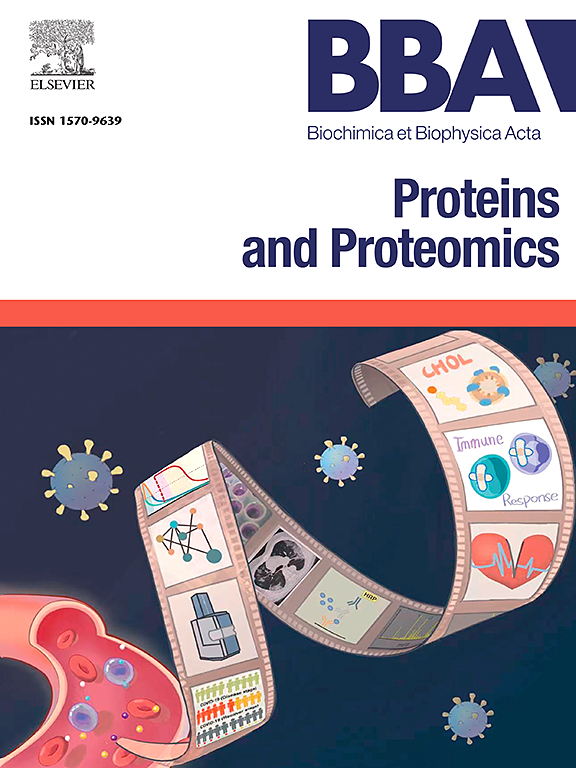Synovial fluid glycoproteome profiling in knee osteoarthritis: Molecular insights into type 2 diabetes-associated biomarkers and therapeutic targets
IF 2.3
4区 生物学
Q3 BIOCHEMISTRY & MOLECULAR BIOLOGY
Biochimica et biophysica acta. Proteins and proteomics
Pub Date : 2025-03-27
DOI:10.1016/j.bbapap.2025.141067
引用次数: 0
Abstract
Type 2 diabetes mellitus (T2DM) and Osteoarthritis (OA) share common risk factors like age, obesity and hypertension. Currently, 52 % of diabetic patients suffer from arthritis. Diabetes facilitates OA by altering lipid metabolism, levels of adipokines & cytokines, accumulation of advanced glycation end products, etc., which affects cartilage & bone health. However, the molecular mechanisms of the association of OA with T2DM remain unexplored. Since diabetes greatly affects the glycosylation status of proteins, the present study focused on identifying glycoproteins that could serve as diagnostic and prognostic markers for identifying osteoarthritis in diabetic individuals by LC-MS/MS. Comparative proteomic analysis revealed 20 significantly altered glycoproteins; among them, thyroxine-binding globulin (THBG), alpha-1-antitrypsin (A1AT), fibrinogen gamma chain (FGG) and angiotensinogen (AGT) were further validated. THBG, A1AT and AGT showed promising potential to identify the comorbid condition in serum and synovial fluid, however, ROC analysis identified THBG as the best candidate glycoprotein marker. Upregulation of THBG in OADM disrupts the bone remodeling cycle, degrades insulin, and promotes the expression of GLUT-1 and MMP-9. Overall, THBG could also serve as a therapeutic target for reducing the progression of osteoarthritis and alleviating pain and bone stiffness associated with the disease.
膝关节骨关节炎的滑液糖蛋白组分析:2型糖尿病相关生物标志物和治疗靶点的分子见解
2型糖尿病(T2DM)和骨关节炎(OA)有共同的危险因素,如年龄、肥胖和高血压。目前,52. %的糖尿病患者患有关节炎。糖尿病通过改变脂质代谢、脂肪因子和细胞因子的水平、晚期糖基化终产物的积累等来促进骨关节炎,从而影响软骨和骨骼的健康。然而,骨性关节炎与2型糖尿病相关的分子机制尚不清楚。由于糖尿病极大地影响了蛋白质的糖基化状态,因此本研究的重点是通过LC-MS/MS鉴定可作为糖尿病患者骨关节炎诊断和预后标志物的糖蛋白。对比分析发现20个糖蛋白显著改变;其中,甲状腺素结合球蛋白(THBG)、α -1-抗胰蛋白酶(A1AT)、纤维蛋白原γ链(FGG)和血管紧张素原(AGT)进一步验证。THBG、A1AT和ANGT在血清和滑液中显示出识别合并症的潜力,然而,ROC分析发现THBG是最佳候选糖蛋白标志物。OADM中THBG的上调破坏骨重塑周期,降解胰岛素,促进GLUT-1和MMP-9的表达。总的来说,THBG也可以作为治疗靶点,减少骨关节炎的进展,减轻与疾病相关的疼痛和骨僵硬。
本文章由计算机程序翻译,如有差异,请以英文原文为准。
求助全文
约1分钟内获得全文
求助全文
来源期刊
CiteScore
8.00
自引率
0.00%
发文量
55
审稿时长
33 days
期刊介绍:
BBA Proteins and Proteomics covers protein structure conformation and dynamics; protein folding; protein-ligand interactions; enzyme mechanisms, models and kinetics; protein physical properties and spectroscopy; and proteomics and bioinformatics analyses of protein structure, protein function, or protein regulation.

 求助内容:
求助内容: 应助结果提醒方式:
应助结果提醒方式:


